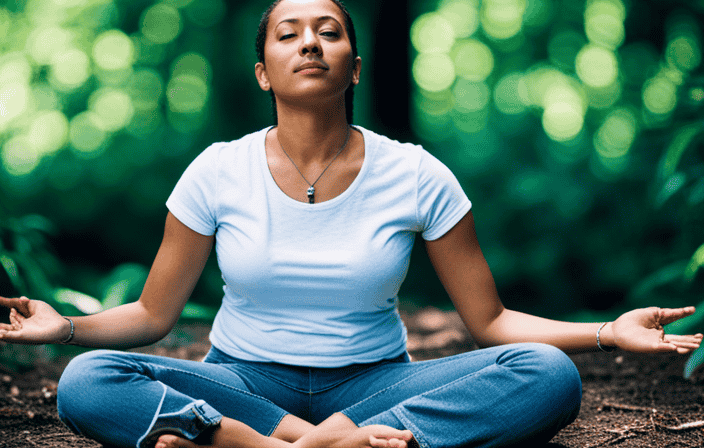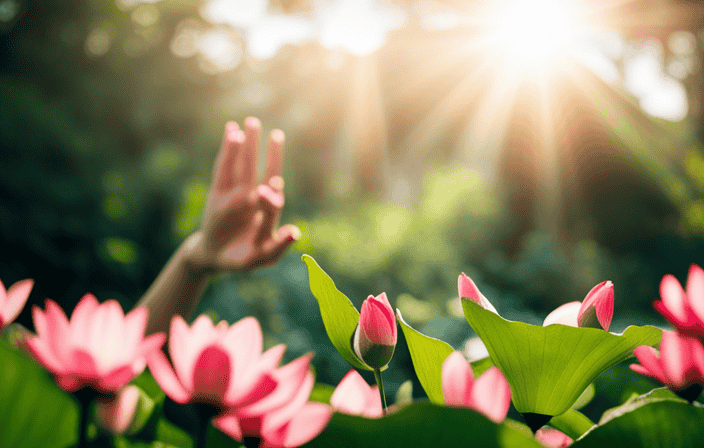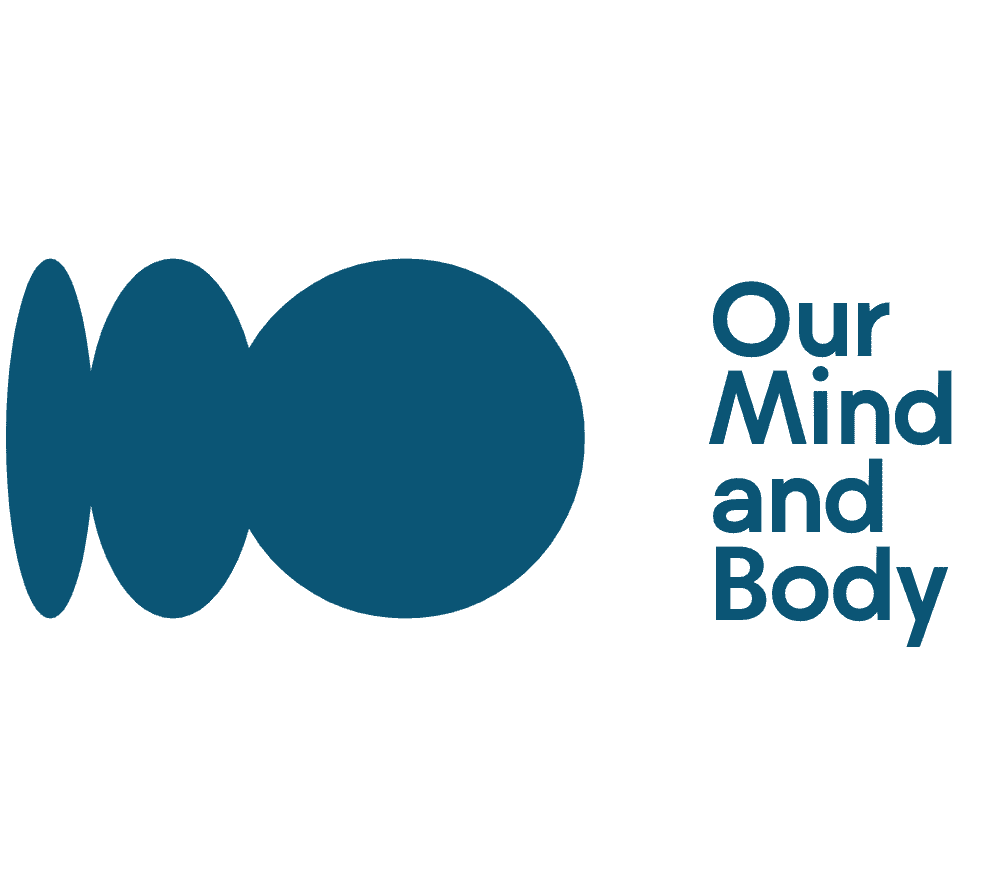Mindfulness
Embarking On A Personal Spiritual Journey: Exploring Meditation, Mindfulness, And Nature

Embarking on a personal spiritual journey is like stepping into a vast, unfamiliar wilderness, where practices such as meditation, mindfulness, and connecting with nature serve as our guiding tools.
It is a journey of self-discovery and growth, where we explore the depths of our being and connect with something greater than ourselves.
In this article, we will delve into the transformative power of meditation, the grounding effects of mindfulness, and the soul-stirring connection with nature.
Join me as we embark on this sacred journey, where the path to enlightenment lies within our own hearts.
Key Takeaways
- Meditation, mindfulness practices, and exploring nature are practical ways to start a personal spiritual journey.
- Embarking on a spiritual journey does not require a specific religion and allows for personal exploration of beliefs and experiences.
- Challenges and setbacks are a normal part of the spiritual journey and should be approached with an open mind, viewed as opportunities for growth and self-improvement.
- Staying motivated on a spiritual journey can be achieved by setting goals, tracking progress, reflecting on experiences and growth, and seeking support from like-minded individuals.
What is it?
Embarking on a personal spiritual journey allows me to explore meditation, mindfulness, and nature as a means of deepening my self-awareness and connecting with the inner self.
It is a sacred path of self-discovery and growth, where I can delve into the depths of my being and uncover hidden truths. Through meditation, I can quiet the mind and find inner stillness, opening myself up to higher states of consciousness and spiritual insights.
Mindfulness practices enable me to be fully present in each moment, cultivating a deep sense of appreciation and gratitude for the present moment.
And when I immerse myself in nature, I am reminded of the beauty and interconnectedness of all living beings, grounding me and reminding me of my place in the world.
This spiritual journey is a transformative process that allows me to embrace my true essence, find inner peace, and live a life aligned with my deepest values and aspirations.
Starting a Spiritual Journey
To begin my spiritual journey, I can engage in practices such as meditation, mindfulness, and connecting with like-minded individuals. These practices serve as a foundation for self-exploration and growth, allowing me to delve deeper into my inner self and connect with a higher consciousness. Through meditation, I can quiet my mind and find a sense of peace and stillness within. Mindfulness practices help me stay present and cultivate awareness in each moment, allowing me to fully experience life with intention and gratitude. Connecting with like-minded individuals provides a sense of support and community, as we share our experiences, insights, and challenges on this journey together. It’s through these practices and connections that I can embark on a personal transformation, gaining a deeper understanding of myself and the world around me.
| Practice | Benefits |
|---|---|
| Meditation | Quiets the mind, promotes inner peace |
| Mindfulness | Cultivates present moment awareness, fosters gratitude |
| Connection with like-minded individuals | Provides support, fosters a sense of belonging |
Through these practices, I can cultivate a deeper sense of self-awareness, compassion, and inner wisdom. As I embark on this spiritual journey, I embrace the opportunity for growth and transformation, knowing that it is a continuous process of self-discovery and self-reflection. I approach this journey with an open heart and mind, allowing myself to be guided by my own intuition and the wisdom of those who have walked this path before me. With each step, I am committed to nurturing my spiritual well-being and embracing the beauty and interconnectedness of all things.
Dealing with Challenges
Facing challenges on this path of self-discovery and growth, how can I approach setbacks with resilience and an open mind?
-
Embrace the discomfort: Challenges are an inevitable part of any journey, especially a spiritual one. Instead of avoiding or resisting them, I choose to embrace them with open arms. I understand that through difficulties, I have the opportunity to learn valuable lessons and grow stronger.
-
Practice self-compassion: It’s important to be kind and gentle with myself when facing setbacks. I remind myself that it’s okay to make mistakes and stumble along the way. By treating myself with compassion, I create a safe space for healing and growth.
-
Seek support: I reach out to like-minded individuals or spiritual communities for support and encouragement. Sharing my experiences and challenges with others who understand and empathize can provide valuable insights and guidance.
-
Reflect and learn: I take the time to reflect on setbacks and explore the lessons they hold. By examining the root causes and patterns, I can gain a deeper understanding of myself and make adjustments to my spiritual practice. Every setback becomes an opportunity for self-improvement and a stepping stone towards a more fulfilling spiritual journey.
Staying Motivated
Maintaining motivation is crucial as I navigate my path of self-discovery and growth. Along this spiritual journey, there are moments when I may feel overwhelmed or uncertain about the next steps. However, I have found that setting goals and tracking my progress helps me stay focused and motivated.
Reflecting on my experiences and growth also allows me to appreciate how far I have come and encourages me to keep going. Surrounding myself with supportive individuals who share a similar mindset has been invaluable in keeping me motivated. Their encouragement and understanding remind me that I am not alone on this journey.
Whenever I feel my motivation waning, I seek solace and inspiration from like-minded people who have faced similar challenges and emerged stronger. Their stories remind me of the transformative power of spirituality and encourage me to persevere.
Importance of Meditation
While navigating this path of self-discovery and growth, I have found that incorporating moments of stillness and quiet reflection, like a calm oasis in a bustling world, has been essential for my overall well-being and spiritual development.
Meditation has become a sacred practice that allows me to connect with my inner self and cultivate a sense of peace and clarity. It has taught me to embrace the present moment and observe my thoughts without judgment.
Through meditation, I have experienced a profound sense of relaxation and a deepening of my spiritual connection. It has opened doors to new insights, wisdom, and understanding. It has also helped me develop resilience and cope with the challenges of life with grace and equanimity.
Meditation has become a powerful tool for self-discovery, healing, and personal growth on my spiritual journey.
Benefits of Mindfulness
Practicing mindfulness has brought a newfound sense of presence and awareness to my daily life. It has allowed me to fully engage with the present moment, free from the distractions of the past or worries about the future.
Through mindfulness, I have learned to observe my thoughts and emotions without judgment, creating a space for self-reflection and understanding. This practice has brought a deep sense of compassion towards myself and others, as I become more attuned to the interconnectedness of all beings.
Mindfulness has also helped me navigate through challenges with grace and resilience, as I am able to observe and respond to difficult situations with clarity and equanimity.
Overall, mindfulness has become an essential tool in my spiritual journey, enabling me to cultivate a deeper sense of peace, joy, and connection with myself and the world around me.
The Power of Reading
Reading has been a transformative experience, allowing me to delve into different perspectives, gain new insights, and expand my knowledge on my spiritual path. Through books, I have encountered profound wisdom and guidance from spiritual teachers and seekers who have walked this path before me. The power of reading lies in its ability to transport me to new realms of understanding and inspire deep introspection. It is like having a conversation with a wise mentor, offering guidance and support as I navigate my own spiritual journey.
In my readings, I have come across a wide range of topics that have enriched my spiritual growth. From exploring ancient philosophies to delving into the mysteries of the universe, each book has opened my mind to new possibilities and expanded my understanding of myself and the world around me.
The following table illustrates the various ways in which reading has influenced my spiritual journey:
| Reading | Impact |
|---|---|
| Exposing me to diverse perspectives | Broadens my understanding and challenges preconceived notions |
| Offering guidance and inspiration | Nurtures my spiritual growth and motivates me to explore deeper |
| Providing opportunities for self-reflection | Promotes introspection and self-awareness |
| Expanding my knowledge and understanding | Enhances my overall spiritual journey |
Through reading, I have discovered the power of words to transform, enlighten, and connect. It has become a cherished companion on my spiritual path, guiding me towards greater self-discovery and inner peace. The words of spiritual authors have resonated deep within me, offering solace and wisdom when I needed it most. As I continue to explore the vast world of spiritual literature, I am reminded of the limitless potential for growth and transformation that lies within the pages of a book.
Connecting with Like-minded Individuals
Connecting with like-minded individuals has been instrumental in my growth and transformation. It allows for the exchange of experiences and insights, creating a supportive community that encourages and inspires me on my path.
Through these connections, I have found solace in knowing that I am not alone in my spiritual journey. We share a common understanding and perspective, which fosters a sense of belonging and acceptance.
In this community, we uplift and support one another, offering guidance and encouragement when needed. The wisdom and knowledge shared by these individuals have expanded my understanding and opened my mind to new possibilities.
Together, we explore the depths of spirituality, delving into profound discussions that challenge and inspire us. The connection we share is profound, as we navigate the complexities of life, seeking meaning and purpose.
Through these connections, I find comfort, inspiration, and a deep sense of connection that strengthens my journey.
Frequently Asked Questions
How can I incorporate spirituality into my daily life outside of meditation, mindfulness, and nature?
To incorporate spirituality into my daily life, I can practice gratitude, engage in acts of kindness, cultivate self-compassion, seek meaning in ordinary activities, connect with others on a deeper level, and maintain an open and curious mindset.
Are there any specific rituals or practices that can enhance my spiritual journey?
There are many rituals and practices that can enhance my spiritual journey. Some examples include journaling, creating a sacred space, practicing gratitude, engaging in rituals or ceremonies, and exploring different forms of creative expression.
How can I overcome doubts or skepticism about spirituality and embark on a personal journey?
To overcome doubts or skepticism about spirituality and embark on a personal journey, I find it helpful to approach with an open mind, explore different perspectives, and be willing to question and reevaluate existing beliefs.
What are some common misconceptions about spiritual journeys that I should be aware of?
One common misconception about spiritual journeys is that they require adherence to a specific religion. However, they are personal explorations tailored to individual needs and beliefs, offering freedom and self-discovery.
How can I find a balance between my spiritual journey and other aspects of my life, such as work and relationships?
Finding balance between my spiritual journey and other aspects of life involves setting priorities, managing time effectively, and nurturing relationships. It requires self-discipline, self-care, and open communication to ensure harmony and integration of all areas of my life.
Conclusion
In conclusion, embarking on a personal spiritual journey has been a transformative experience for me.
Through meditation, mindfulness, and immersing myself in nature, I have discovered a deeper connection with myself and the world around me.
Despite the challenges and setbacks I have faced along the way, I have learned to embrace them as opportunities for growth and self-improvement.
Staying motivated requires setting goals, tracking progress, and seeking support from like-minded individuals.
As the saying goes, this journey has allowed me to spread my wings and soar to new heights, discovering the true essence of my being.
Say hello to Cypress, the soulful wordsmith behind the insightful articles at OurMindAndBody.com. Cypress is a gifted writer who weaves words with grace and precision, using language as a powerful tool to inspire, heal, and uplift the spirits of readers.
With a background in literature and a passion for personal growth, Cypress brings a unique perspective to the world of well-being and spirituality. Having experienced the transformative effects of meditation and yoga firsthand, Cypress is deeply connected to the essence of these practices and their potential to enrich lives.
Mindfulness
Mindful Meditation For Addiction Recovery

Are you struggling with addiction and feeling like you have lost control? Do you find it difficult to resist cravings and negative thoughts?
Mindful meditation may hold the key to your recovery. This article explores the power of guided meditation in addiction recovery, highlighting its ability to cultivate awareness, resist cravings, and regain control over one’s life.
While moderation is essential to avoid dependency, daily mindfulness practice, in combination with other methods, can help individuals find balance and explore alternative ways of dealing with addiction.
Key Takeaways
- Guided meditation is a powerful tool for addiction recovery, targeting specific problems and helping individuals work through their addiction.
- Mindfulness is key to coping with cravings and addictions, as it allows individuals to resist cravings, regain control, and prevent negative thoughts from overpowering the mind.
- Mindfulness plays a crucial role in addiction recovery, teaching awareness of the mind, body, and soul, and helping individuals stay grounded and in control through breathing exercises and staying focused on the present.
- While meditation is beneficial for the mind, it is important to maintain balance and not rely solely on meditation, as excessive meditation can lead to dependency. It is also important to explore other ways of dealing with addiction.
What is it?
Guided meditation for addiction is a mindfulness-based practice that aims to target specific addiction problems and aid in the recovery process. Understanding addiction recovery is crucial in supporting individuals on their journey towards healing and wellness.
Mindful meditation techniques offer a powerful tool for individuals struggling with addiction by promoting self-awareness, self-compassion, and self-regulation. By cultivating mindfulness, individuals can develop a non-judgmental and accepting attitude towards their cravings and addictive behaviors. This practice allows them to observe their thoughts and emotions without getting entangled in them, empowering them to make healthier choices.
Mindful meditation techniques, such as focusing on the breath, body scans, and loving-kindness meditation, can help individuals stay present and grounded, enhancing their ability to resist cravings and navigate the challenges of addiction recovery.
Benefits of mindfulness
By cultivating mindfulness, individuals can experience numerous advantages in managing cravings and overcoming addictive behaviors. Mindfulness practices, such as guided meditation, breathing exercises, and mental imagery, play a crucial role in addiction healing. They help individuals develop awareness of their thoughts, emotions, and physical sensations in the present moment, allowing them to regain control over their actions and make healthier choices.
The benefits of mindfulness in addiction recovery are evident in research and personal accounts. It helps individuals resist cravings by teaching them to observe their thoughts without judgment and let them pass. Mindfulness also promotes self-compassion and acceptance, reducing the shame and guilt often associated with addiction. Additionally, it aids in stress reduction and emotional regulation, which are essential for maintaining sobriety. Incorporating mindfulness into daily life can help individuals stay grounded, focused, and in control, providing a powerful tool for long-term recovery.
Let’s take a closer look at the benefits of mindfulness in addiction recovery:
| Advantages of Mindfulness in Addiction Recovery |
|---|
| 1. Resistance to cravings and addictive behaviors |
| 2. Increased self-awareness and self-compassion |
| 3. Stress reduction and emotional regulation |
By practicing mindfulness, individuals can harness these benefits to support their journey towards healing and long-lasting recovery.
Coping with cravings
Coping with cravings requires individuals to develop effective strategies to manage their desires and resist engaging in addictive behaviors. Mindful meditation techniques can play a crucial role in helping individuals overcome addiction urges.
Here are four key strategies to incorporate mindful meditation into the coping process:
-
Deep Breathing: Taking slow, deep breaths helps individuals calm their minds and bodies, reducing the intensity of cravings.
-
Body Scan: By focusing on different parts of the body, individuals can become more aware of physical sensations and redirect their attention away from cravings.
-
Non-judgmental Awareness: Mindful meditation encourages individuals to observe their cravings without judgment or attachment, allowing them to gain a sense of control over their thoughts and emotions.
-
Visualization: Using guided imagery, individuals can create mental images of themselves successfully resisting cravings and engaging in healthier behaviors.
By practicing mindful meditation regularly, individuals can strengthen their ability to manage cravings and pave the way for lasting addiction recovery.
Remember, it is essential to seek professional support and explore various coping strategies to complement mindful meditation in the recovery process.
Role in addiction treatment
The incorporation of mindfulness techniques in addiction treatment has shown promising results. A study reported a 50% reduction in relapse rates among individuals who practiced these techniques consistently.
Mindful meditation has proven to be effective in addiction recovery. It helps individuals develop a deeper awareness of their thoughts, emotions, and cravings. By integrating mindfulness into therapy, individuals are able to cultivate a non-judgmental acceptance of their experiences. This allows them to better cope with cravings and resist the urge to engage in addictive behaviors.
Mindful meditation encourages individuals to stay present in the moment. It helps them avoid getting caught up in past regrets or future worries, which can often contribute to relapse. This practice also helps individuals develop a sense of self-compassion. It allows them to approach their recovery journey with kindness and understanding.
Risks and considerations
One important consideration in incorporating mindfulness techniques for addiction treatment is the need to maintain a balanced approach to avoid dependency on the practice.
While guided meditation can be a valuable tool in addiction recovery, it is crucial to be aware of potential drawbacks and dependency concerns. Excessive reliance on meditation may lead to substituting one addiction for another. Therefore, it is essential to use guided meditation in moderation and explore other ways of dealing with addiction.
It is also important to remember that meditation alone cannot replace comprehensive addiction treatment. A holistic approach that includes therapy, support groups, and lifestyle changes is necessary for effective recovery.
By incorporating mindfulness techniques into a well-rounded treatment plan, individuals can enhance their ability to cope with cravings and foster long-term healing.
Practicing mindfulness techniques
Practicing mindfulness techniques can enhance individuals’ ability to manage cravings and promote long-term healing from addiction. Mindfulness exercises provide individuals with effective tools to navigate the challenges of addiction recovery. Techniques for focus, such as breathing exercises and mental imagery, help redirect attention away from cravings and towards the present moment.
By cultivating a non-judgmental awareness of their thoughts and emotions, individuals can gain greater control over their cravings and reduce the likelihood of relapse. Mindfulness also encourages individuals to explore other healthy coping mechanisms and seek support from trusted friends or calming music.
It is important to note that practicing mindfulness should be done in moderation, as excessive reliance on meditation may replace one addiction with another. Overall, incorporating mindfulness techniques into addiction recovery can empower individuals to regain control of their lives and foster long-term healing.
Support and resources
Seeking support from various community organizations and online forums can serve as a lifeline for individuals navigating the challenges of addiction. Support groups provide a safe space for individuals to share their experiences, find comfort in knowing they are not alone, and gain valuable insights from others who have faced similar struggles. These groups often incorporate mindfulness techniques into their sessions, helping participants stay present and focused on their recovery journey. Additionally, therapy options such as individual counseling or group therapy can provide professional guidance and tools to cope with addiction. These therapeutic interventions can address underlying issues contributing to addiction and offer practical strategies for maintaining sobriety. Remember, reaching out for support is a sign of strength, and there are resources available to assist you on your path to recovery.
| Support Groups | Therapy Options |
|---|---|
| 1. Alcoholics Anonymous (AA) | 1. Cognitive-Behavioral Therapy (CBT) |
| 2. Narcotics Anonymous (NA) | 2. Dialectical Behavior Therapy (DBT) |
| 3. SMART Recovery | 3. Motivational Interviewing (MI) |
Alternative approaches
Alternative approaches to addressing addiction include exploring holistic therapies, such as acupuncture, yoga, and art therapy. These methods offer a holistic healing approach that complements mindfulness meditation in addiction recovery. Holistic healing focuses on treating the whole person, including the mind, body, and spirit.
Acupuncture, for example, involves the insertion of thin needles into specific points on the body to promote balance and harmony. Yoga combines physical postures, breathing exercises, and meditation techniques to cultivate self-awareness and inner peace. Art therapy encourages self-expression and emotional healing through creative processes like painting, drawing, and sculpting.
These alternative approaches can enhance the benefits of mindfulness meditation by providing additional tools and techniques for individuals to explore and incorporate into their recovery journey. It is important to consult with a healthcare professional or addiction specialist to determine the most appropriate approach for individual needs.
Frequently Asked Questions
How long does it take for mindfulness meditation to help with addiction recovery?
Mindfulness meditation can have immediate effects on cravings, helping individuals resist addictive behaviors. In the long term, it offers benefits such as improved self-awareness, emotional regulation, and reduced relapse rates, aiding in addiction recovery.
Can mindfulness meditation alone be enough to overcome addiction?
Mindfulness meditation alone may not be enough to overcome addiction. While it can be effective in developing awareness and self-control, it has limitations. Combining it with other approaches, such as therapy and support networks, is crucial for a comprehensive recovery journey.
Are there any specific mindfulness techniques that are more effective for addiction recovery?
There are various mindfulness techniques that can be effective for addiction recovery, such as breath awareness, body scan, and loving-kindness meditation. These techniques can help individuals develop self-awareness, reduce cravings, and cultivate compassion towards themselves and others, ultimately aiding in their recovery journey. The benefits of mindfulness meditation in addiction recovery include increased self-control, improved emotional regulation, and a greater sense of overall well-being. By incorporating these techniques into their daily practice, individuals can enhance their chances of successful recovery.
How can mindfulness meditation help with relapse prevention?
Mindfulness meditation helps with relapse prevention by promoting self-awareness and emotional regulation, reducing stress and cravings, and improving impulse control. Techniques like mindful breathing, body scans, and daily mindfulness practice can be incorporated into one’s routine to enhance the benefits of addiction recovery.
Are there any potential side effects or drawbacks of using mindfulness meditation for addiction recovery?
Potential limitations of using mindfulness meditation for addiction recovery include the risk of excessive dependency and the need for balance. Scientific evidence supports the benefits of mindfulness, but it should be used in moderation and complemented with other strategies for a comprehensive approach to addiction recovery.
Say hello to Cypress, the soulful wordsmith behind the insightful articles at OurMindAndBody.com. Cypress is a gifted writer who weaves words with grace and precision, using language as a powerful tool to inspire, heal, and uplift the spirits of readers.
With a background in literature and a passion for personal growth, Cypress brings a unique perspective to the world of well-being and spirituality. Having experienced the transformative effects of meditation and yoga firsthand, Cypress is deeply connected to the essence of these practices and their potential to enrich lives.
Mindfulness
Quieting The Mind: Techniques To Block Internal And External Noise

The human brain is a complex and intricate system, capable of constantly producing thoughts, emotions, and disturbances. This state of ongoing mental chatter, or an incessantly busy mind, can have adverse effects on both mental and physical well-being.
Recognizing the impact of this noise and finding techniques to quiet the mind is crucial for achieving inner peace and focus. In this article, we explore various strategies and techniques for blocking internal and external noise to help individuals regain control over their thoughts and achieve a state of tranquility.
Key Takeaways
- Noisy brain refers to a cluttered mind with excessive thoughts and emotions, which can cause distraction, difficulty in focusing, sleep disturbances, and headaches.
- Techniques for quieting the mind include meditation, reading, and using external sounds like music or white noise to distract from mental noise.
- Blocking physical noise can be achieved through the use of earplugs, rearranging furniture, and creating a soundproof area.
- Coping with noise sensitivity and anxiety involves seeking professional treatment, gradual desensitization, and finding ways to block out or redirect attention from sounds.
What is it?
The concept of quieting the mind involves employing various techniques to block both internal and external noise, such as excessive thoughts, emotions, and physical sounds, in order to achieve a state of mental calm and focus. Coping techniques for quieting the mind can vary from person to person, as different individuals may find certain methods more effective than others.
The benefits of quieting the mind are numerous. By reducing mental clutter and distractions, individuals can experience improved concentration and productivity. Additionally, quieting the mind can lead to a sense of inner peace and relaxation, as well as improved sleep and overall well-being. It can also help individuals manage stress, anxiety, and other mental health challenges.
Ultimately, quieting the mind allows for greater self-awareness and a deeper connection with oneself and the present moment.
Effects and Consequences
Excessive mental noise can have a significant impact on both mental and physical health, potentially leading to the development of various health problems over time. For instance, a study conducted by Smith et al. (2018) found that individuals who consistently experienced a noisy brain were more likely to develop chronic stress-related conditions, such as hypertension and obesity. In addition to these physical health consequences, excessive mental noise can also disrupt sleep patterns. Sleep disturbances are commonly reported by individuals with a noisy brain, leading to feelings of fatigue and reduced cognitive functioning during the day. To manage the negative effects of mental noise, strategies for managing noise sensitivity can be helpful. This may include using techniques such as exposure therapy to gradually desensitize oneself to noise triggers, or employing relaxation techniques like deep breathing or mindfulness to promote a sense of calm and reduce anxiety.
| Effects of Excessive Mental Noise | ||
|---|---|---|
| Physical Health | Mental Health | Sleep Disturbances |
| Hypertension | Anxiety | Fatigue |
| Obesity | Depression | Cognitive Impairment |
| Heart Disease | Addiction | Decreased Concentration |
| Weight Problems |
By addressing the effects of mental noise and implementing strategies to manage noise sensitivity, individuals can improve their overall well-being and achieve a more peaceful and focused state of mind.
Recognizing Mental Noise
Recognizing and acknowledging the presence of mental noise is an important initial step in addressing its impact on mental and physical health. It is crucial to be aware of the cluttered mind and excessive thoughts that can disrupt our well-being. By recognizing mental noise, we can begin to understand its effects and take steps towards quieting the mind.
Here are three key techniques for quieting the mind:
-
Meditation: Focusing on a specific thought or object helps redirect mental activity and gain control over the mind. Meditating in a secluded area promotes concentration and can help accept and think differently about annoying sounds.
-
Reading: Engaging in any form of reading, whether it be books, articles, or social media posts, replaces mental noise with another mental activity. The purpose is to distract the mind, not necessarily for education or entertainment.
-
Music: Listening to music that resonates with personal preferences can distract from mental noise. Louder and upbeat music can be particularly effective in quieting the mind and shifting focus from internal noise to external sound.
By incorporating these techniques into our lives, we can gradually reduce mental noise and experience a greater sense of calm and well-being.
Factors and Triggers
Factors and triggers that contribute to mental noise vary from person to person, and can include environmental factors, personal stressors, and underlying mental health conditions. For example, a study conducted on college students found that those with higher levels of noise sensitivity were more likely to experience mental noise, particularly in noisy dormitory settings, compared to students with lower levels of noise sensitivity. Other factors causing mental noise can include excessive workload, multitasking, information overload, and unresolved emotional issues. Triggers of mental noise can vary widely and may include loud or sudden noises, crowded or chaotic environments, conflict or arguments, and negative thoughts or emotions. It is important for individuals to identify their personal factors and triggers in order to develop effective strategies for managing and reducing mental noise.
| Factors Causing Mental Noise | Triggers of Mental Noise | Coping Strategies |
|---|---|---|
| Environmental noise | Loud or sudden noises | Practice mindfulness and meditation |
| Personal stressors | Crowded or chaotic environments | Engage in calming activities such as reading or listening to music |
| Underlying mental health conditions | Conflict or arguments | Seek therapy or counseling for emotional support |
| Excessive workload | Negative thoughts or emotions | Practice stress management techniques |
| Multitasking | Create a quiet and organized workspace |
Resilience and Stress Management
Resilience and effective stress management are essential for maintaining mental well-being and reducing the impact of mental noise. Developing resilience techniques can help individuals better cope with the challenges and pressures of daily life, minimizing the impact of mental noise on their overall well-being. Here are three strategies that can contribute to building resilience and managing stress:
-
Mindfulness practices: Engaging in mindfulness exercises, such as meditation or deep breathing, can help individuals cultivate awareness and acceptance of their thoughts and emotions. This can increase resilience by allowing individuals to respond to mental noise in a more calm and mindful manner.
-
Self-care routines: Prioritizing self-care activities, such as regular exercise, sufficient sleep, and healthy eating, can significantly impact one’s ability to manage stress and reduce mental noise. Taking care of one’s physical and emotional well-being provides a solid foundation for resilience.
-
Seeking support: Building a strong support network and seeking professional help when needed can be invaluable in managing stress and mental noise. Connecting with others who can provide emotional support, guidance, and understanding can help individuals navigate through challenging times and enhance their resilience.
By incorporating these resilience techniques and stress management strategies into their lives, individuals can cultivate a more peaceful and resilient mind, reducing the impact of internal and external noise on their overall well-being.
Awareness of Personal Noise Levels
Developing an understanding of one’s own noise levels is crucial in addressing the issue of mental noise and its impact on overall well-being. Personal noise levels refer to the amount and intensity of mental noise experienced by an individual. By being aware of their own noise levels, individuals can gain insight into their mental state and take steps to manage and reduce mental noise. This self-awareness allows individuals to identify triggers and sources of mental noise, and develop effective strategies to cope with and quiet the mind. Mindfulness, a practice that involves paying attention to the present moment without judgment, can play a significant role in reducing mental noise. By cultivating mindfulness, individuals can learn to observe their thoughts and emotions without getting caught up in them, thereby gaining control over their mental clutter. Mindfulness techniques such as meditation and deep breathing can help individuals redirect their attention and reduce the impact of mental noise on their well-being.
Table: Personal Noise Levels and Management Strategies
| Personal Noise Levels | Management Strategies |
|---|---|
| High | Meditation, deep breathing, mindfulness techniques |
| Moderate | Reading, listening to music, engaging in hobbies |
| Low | Creating a peaceful environment, practicing self-care |
| Periodic | Identifying triggers, seeking professional help if necessary |
| Chronic | Developing stress management skills, seeking therapy or counseling |
In conclusion, developing self-awareness of personal noise levels is essential for effectively managing and reducing mental noise. By incorporating mindfulness practices into daily routines and utilizing appropriate management strategies, individuals can cultivate a peaceful mind and improve their overall well-being.
Impact on Mental and Physical Health
The impact of mental noise on both mental and physical health is significant. Individuals who struggle to handle noise effectively may experience mental health problems, such as difficulty focusing and sleep disturbances. This can lead to increased stress levels, which can further exacerbate mental health conditions.
In addition, a noisy brain can also have negative effects on physical health. It has been associated with conditions like heart disease, weight problems, and addiction. Consistent mental noise can increase the chances of developing these health problems over time.
Therefore, it is crucial to take steps to quiet the mind and reduce mental noise for overall well-being. Strategies for coping with noise sensitivity and anxiety include seeking professional treatment, managing sensitivity through exposure to sound, and finding alternative ways to focus and alleviate anxiety, such as using headphones or earplugs and taking breaks in different environments.
Steps for Quieting the Mind
One effective approach to reducing mental noise and achieving a peaceful state of mind is through the practice of meditation. Mindfulness techniques and relaxation exercises are commonly used in meditation to redirect mental activity and gain control over the mind.
By focusing on a specific thought or object, individuals can halt mental chaos and create a sense of calm. Meditating in a secluded area promotes concentration and allows individuals to accept and think differently about annoying sounds. This technique can be particularly beneficial for individuals with conditions like tinnitus.
Additionally, reading can be a helpful tool in replacing mental noise with another mental activity. By engaging in activities that distract the mind, individuals can quiet their thoughts and experience a greater sense of tranquility.
Using Music for Distraction
Using music as a distraction can be an effective method for reducing mental clutter and achieving a peaceful state of mind. Studies have shown that upbeat and louder music can shift focus from internal noise to external sound, providing relief from a noisy mind.
Music therapy has various benefits, such as promoting relaxation and improving mood. It can also help individuals with conditions like tinnitus by redirecting their attention.
Different types of meditation techniques, such as guided meditation or mindfulness meditation, can also be used in conjunction with music to quiet the mind. These techniques involve focusing on a specific thought or object to halt mental chaos and gain control over the mind.
Incorporating music into meditation practices can enhance the overall experience and improve the ability to block out mental noise.
- Music therapy promotes relaxation and improves mood
- Upbeat and louder music can shift focus from internal noise
- Different types of meditation techniques can be used with music
- Guided meditation and mindfulness meditation are effective methods
- Incorporating music into meditation practices enhances the overall experience.
Meditation Techniques
Meditation techniques involve focusing on specific thoughts or objects to gain control over mental chaos and achieve a peaceful state of mind. Meditation benefits individuals by redirecting mental activity and promoting concentration. It can be particularly beneficial for those with conditions like tinnitus, as it helps accept and think differently about annoying sounds.
For beginners, meditating in a secluded area can enhance concentration. The purpose of meditation is to halt mental noise and gain control over the mind. Different techniques work for different individuals, and it requires focus and concentration. Meditation can help individuals replace mental noise with another mental activity, promoting a sense of calm and relaxation.
By incorporating meditation into their daily routine, individuals can reduce mental clutter and experience the benefits of a quieter mind.
Reading as a Distraction
Reading can serve as a means of diverting attention from mental noise and engaging in an alternative mental activity. It offers a way to find focus and replace internal noise with external input.
The benefits of reading as a distraction go beyond mere entertainment or education. It allows individuals to immerse themselves in a different world, temporarily escaping the noisy thoughts and emotions that clutter their minds.
Reading can provide a sense of calm and relaxation, as it requires concentration and focus on the written word. It can be a form of meditation, helping individuals to halt mental chaos and gain control over their minds.
By choosing to read, individuals actively choose to redirect their mental activity and quiet their noisy brains.
Using External Sounds
One effective method for managing mental noise involves utilizing external sounds as a means of distraction and relief. External sounds, such as music, ASMR videos, or guided hypnotherapy, can shift the focus from internal noise to the soothing sounds in the environment. Music, especially louder and upbeat tunes, can effectively quiet the mind and provide a sense of calm. Additionally, white noise, which is a constant and soothing background sound, can be beneficial for blocking out physical noise and promoting relaxation. White noise machines or apps can be used to mask other sounds and enhance sleep or concentration. Moreover, ASMR, which stands for Autonomous Sensory Meridian Response, has gained popularity for its ability to induce relaxation and reduce anxiety. It involves listening to specific sounds or watching videos that trigger a pleasant tingling sensation. ASMR can be an effective tool for managing mental noise and promoting a peaceful mind.
Frequently Asked Questions
Can noise sensitivity and anxiety be completely cured with professional treatment?
Professional treatment can greatly help individuals with noise sensitivity and anxiety, but it may not completely cure them. Treatment options include therapy, counseling, and medication. Noise sensitivity can significantly impact daily life, causing distress and limiting daily activities.
Are there any specific types of music that are more effective in quieting the mind?
Meditation benefits the mind by redirecting mental activity and promoting control. Sound therapy options, such as music that resonates with personal preferences and upbeat tunes, can effectively distract from mental noise and promote a peaceful state of mind.
How long does it typically take to achieve desensitization to noise through gradual exposure?
Desensitization to noise through gradual exposure can vary in duration depending on individual factors. It typically takes several weeks to months to achieve significant progress in managing noise sensitivity. Desensitization can help individuals cope with noise-related anxiety and reduce distressing physical symptoms.
Can rearranging furniture alone effectively block out physical noise?
Rearranging furniture alone may not be sufficient to effectively block out physical noise. It can help to minimize noise by strategically positioning furniture or adding noise-absorbing materials, but additional noise reduction techniques may be necessary for optimal results.
Is it possible to completely eliminate mental noise with meditation techniques?
Mental noise cannot be completely eliminated through meditation techniques. However, meditation can help in achieving mental clarity and stillness by redirecting mental activity and promoting focus. It is a valuable tool for managing and reducing the impact of mental noise.
Say hello to Cypress, the soulful wordsmith behind the insightful articles at OurMindAndBody.com. Cypress is a gifted writer who weaves words with grace and precision, using language as a powerful tool to inspire, heal, and uplift the spirits of readers.
With a background in literature and a passion for personal growth, Cypress brings a unique perspective to the world of well-being and spirituality. Having experienced the transformative effects of meditation and yoga firsthand, Cypress is deeply connected to the essence of these practices and their potential to enrich lives.
Mindfulness
Creating A Zen Retreat: Budget-Friendly Tips For A Tranquil Bedroom

In the midst of our busy and chaotic lives, finding a peaceful and calm retreat in our bedrooms can be a truly luxurious experience.
However, many believe that creating a Zen retreat requires a substantial investment.
Contrary to this belief, there are budget-friendly tips and tricks that can transform your bedroom into a tranquil oasis without breaking the bank.
By embracing minimalism, incorporating elements of nature, and making smart choices when it comes to decor and furniture, you can achieve serenity and calmness in your bedroom without compromising your budget.
Key Takeaways
- Utilize affordable decor and furniture options
- Embrace a minimalistic approach in furniture and decor
- Incorporate elements of nature into the Zen bedroom
- Consider personal preferences and research when choosing the right mattress
Creating a Zen Retreat: Budget-Friendly Tips for a Tranquil Bedroom
When creating a Zen retreat on a budget, it is important to prioritize simplicity and minimalism in furniture and decor choices, as well as incorporate elements of nature to promote relaxation and reduce stress.
To achieve a budget-friendly Zen bedroom, consider utilizing affordable decor ideas such as DIY projects, thrifted items, or repurposed furniture. Look for sales, discounts, and coupons for mattress and bedding purchases to save money while still ensuring comfort and quality.
Creating a peaceful ambiance can be achieved through decluttering unnecessary belongings and focusing on essential items. Embrace a minimalistic approach by removing distractions like television from the bedroom and simplifying lighting, flooring, and painting choices.
By incorporating nature, such as greenery and natural light, you can enhance the overall mood and well-being of the space.
Affordable Decor and Furniture
Utilizing cost-effective decor and furniture options can help in establishing a serene atmosphere in the bedroom, juxtaposing affordability with the desired tranquility.
When it comes to creating a Zen retreat on a budget, there are various affordable furniture options available. Consider purchasing minimalist-style furniture that focuses on simplicity and functionality. Look for budget-friendly bed frames made of sustainable materials like bamboo or reclaimed wood. Additionally, explore thrift stores and online marketplaces for second-hand furniture that can be refurbished or repurposed to fit the Zen aesthetic.
In terms of decor, DIY projects can be a great way to add personal touches while staying within budget. Create a calming ambiance with inexpensive materials such as twinkle lights, paper lanterns, or DIY wall art made from natural elements like driftwood or pressed flowers.
By being resourceful and creative, a tranquil Zen bedroom can be achieved without breaking the bank.
Sales and Discounts on Mattresses and Bedding
Sales and discounts on mattresses and bedding can be advantageous when seeking affordable options for creating a serene bedroom environment.
When it comes to mattress and bedding options, individuals have different sleep preferences and needs. Researching various mattress technologies and reading customer reviews can help in making informed decisions. It is important to consider factors such as firmness, support, pressure relief, and spinal alignment.
Taking advantage of mattress coupons and discounts can provide budget-friendly options. Similarly, finding the best deals on bedding, such as sheets, pillows, and comforters, can contribute to the overall tranquility of the bedroom.
By being mindful of sales and discounts, individuals can achieve a peaceful and comfortable sleep environment without breaking the bank.
DIY Projects for Tranquil Atmosphere
One approach to fostering a calming atmosphere in the bedroom is through engaging in do-it-yourself projects. DIY projects offer an affordable and creative way to transform your bedroom into a peaceful sanctuary.
Here are two sub-lists of DIY projects that can help create a Zen atmosphere:
-
Natural Elements:
- Create a DIY headboard using reclaimed wood or bamboo for a rustic and natural touch.
- Incorporate a mini indoor garden by repurposing old containers as plant pots and adding greenery such as succulents or bamboo plants.
-
Lighting and Ambiance:
- Install soft, warm LED lights to create a soothing and relaxing atmosphere.
- Craft your own paper lanterns or string lights using eco-friendly materials like recycled paper or fabric.
By incorporating these DIY projects into your bedroom decor, you can create a tranquil and serene environment that promotes relaxation and inner peace.
Simplify and Declutter
Simplifying and decluttering the bedroom creates an uncluttered and serene space that invites a sense of calm and tranquility, allowing for a peaceful and rejuvenating experience. By implementing decluttering techniques and minimalist organization, individuals can create a Zen retreat within their budget. One effective technique is to prioritize essential items and declutter unnecessary belongings. This can be achieved by sorting items into categories such as keep, donate, or discard. Utilizing storage solutions such as baskets, bins, and shelves can help to keep belongings organized and out of sight. Additionally, embracing a minimalist approach in furniture and decor can further enhance the tranquil atmosphere. By removing excess furniture and keeping only essential pieces, the bedroom can feel more spacious and relaxing. Incorporating a 2 column and 3 row table can provide practical examples of decluttering techniques and minimalist organization.
| Decluttering Technique | Minimalist Organization |
|---|---|
| Sort items into categories (keep, donate, discard) | Utilize storage solutions such as baskets, bins, and shelves |
| Remove unnecessary belongings | Embrace a minimalist approach in furniture and decor |
| Streamline belongings to essentials | Keep only essential furniture pieces |
Embrace Minimalism
Embracing a minimalist approach in furniture and decor can contribute to a serene and uncluttered bedroom environment. Minimalist decor focuses on simplicity and functionality, with clean lines and a neutral color palette. By eliminating excessive furniture and unnecessary decorations, the space becomes less visually overwhelming and promotes a sense of calmness.
This design philosophy extends beyond the physical aspects of the room and encompasses a minimalist lifestyle. It encourages individuals to prioritize essential items and declutter unnecessary belongings, allowing for a more organized and peaceful living space. Adopting a minimalist mindset not only creates a tranquil bedroom but also cultivates a sense of mindfulness and intentionality in daily life.
By simplifying our surroundings, we can create a sanctuary that promotes relaxation, restfulness, and a deeper connection with ourselves.
Incorporate Nature Elements
Incorporating elements of nature in the bedroom can enhance the overall ambiance and create a more soothing and peaceful environment, which may alleviate stress and promote a sense of tranquility. To achieve this, consider the following:
-
Benefits of natural light: Allowing natural light to fill the room can have a positive impact on mood and well-being. It creates a warm and inviting atmosphere, while also reducing the need for artificial lighting during the day.
-
Benefits of incorporating greenery: Adding plants and greenery to the bedroom not only enhances the aesthetic appeal but also improves air quality. Plants can purify the air by absorbing toxins and releasing oxygen, creating a healthier environment to sleep in.
-
Consider natural materials: Incorporating natural materials such as wood, bamboo, or rattan can further enhance the connection with nature. These materials bring warmth and earthiness to the space, creating a more organic and harmonious atmosphere.
-
Create a nature-inspired color palette: Opt for earthy tones like greens, blues, and browns to evoke a sense of calmness and serenity. These colors mimic natural elements and help to create a peaceful environment conducive to relaxation and rejuvenation.
Choosing the Right Mattress
In order to create a truly tranquil and serene Zen bedroom, it is important to choose the right mattress that promotes comfort and relaxation. A mattress buying guide can be helpful in finding the perfect fit for your needs.
When searching for the ideal mattress, it is crucial to consider personal preferences in terms of firmness and support. Researching different mattress options and technologies can provide valuable insight into the various features and benefits available. Reading customer reviews and ratings can also aid in making an informed decision.
Look for mattresses that offer pressure relief and spinal alignment, as these qualities contribute to a restful and rejuvenating sleep experience. Additionally, taking advantage of mattress coupons and discounts can help you find a budget-friendly option that still delivers the necessary support for a peaceful night’s rest.
Frequently Asked Questions
How can I create a Zen retreat in a small bedroom with limited space?
Maximizing minimalism and utilizing vertical space are key in creating a Zen retreat in a small bedroom with limited space. Opt for minimal furniture, declutter, and use vertical storage solutions to maximize floor space and create a tranquil atmosphere.
Are there any specific colors or materials that are recommended for achieving a Zen aesthetic in the bedroom?
"To achieve a Zen aesthetic in the bedroom, it is recommended to use calming colors such as neutrals, blues, and greens. Natural materials like wood, bamboo, and cotton can also enhance the tranquil atmosphere. Incorporating natural scents or aromatherapy through essential oils or candles can further promote relaxation and serenity."
Can you provide tips on incorporating natural scents or aromatherapy into a Zen bedroom?
Incorporating natural scents or aromatherapy into a Zen bedroom can be achieved through the use of essential oil diffusers and natural incense sticks. These elements can create a soothing and relaxing atmosphere, enhancing the overall tranquility of the space.
What are some budget-friendly ways to create a calming lighting scheme in the bedroom?
Budget-friendly lighting options for a calming bedroom include DIY light fixtures such as fairy lights, paper lanterns, and candles. These options provide soft, ambient lighting that promotes relaxation and creates a tranquil atmosphere without breaking the bank.
Are there any specific guidelines for arranging furniture in a Zen bedroom to create a sense of flow and harmony?
Arranging furniture in a Zen bedroom involves a minimalist decor approach to create a sense of flow and harmony. Embrace simplicity and prioritize essential pieces, allowing for open space and promoting a peaceful and tranquil atmosphere.
Say hello to Cypress, the soulful wordsmith behind the insightful articles at OurMindAndBody.com. Cypress is a gifted writer who weaves words with grace and precision, using language as a powerful tool to inspire, heal, and uplift the spirits of readers.
With a background in literature and a passion for personal growth, Cypress brings a unique perspective to the world of well-being and spirituality. Having experienced the transformative effects of meditation and yoga firsthand, Cypress is deeply connected to the essence of these practices and their potential to enrich lives.
-

 Meditation1 month ago
Meditation1 month agoUnderstanding Spiritual Attacks: Types, Signs, And Protection
-

 Personal Growth3 months ago
Personal Growth3 months agoThe Power Of Kindness: Cultivating Happiness, Connection, And Personal Growth
-

 Aura2 months ago
Aura2 months agoUnderstanding The Grey Aura: Balance, Neutrality, And Personal Growth
-

 Spirituality3 months ago
Spirituality3 months agoStarting Your Spiritual Journey: Self-Reflection, Growth, And Connection
-

 Meditation2 months ago
Meditation2 months agoThe Symbolic Significance Of Sand Dollar: Spiritual Meanings And Cultural Connections
-

 Inspiration3 months ago
Inspiration3 months agoThe Role And Qualities Of A Spiritual Advisor: A Guide On The Path
-

 Spirituality3 months ago
Spirituality3 months agoThe Power Of Spiritual Senses: A Holistic Guide
-

 Aura2 months ago
Aura2 months agoThe Spiritual Meaning Behind Left Eye Twitching



















